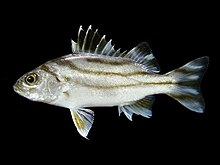Terapon jarbua
| Terapon jarbua | |
|---|---|

| |
| Scientific classification | |
| Domain: | Eukaryota |
| Kingdom: | Animalia |
| Phylum: | Chordata |
| Class: | Actinopterygii |
| Order: | Perciformes |
| Family: | Terapontidae |
| Genus: | Terapon |
| Species: | T. jarbua
|
| Binomial name | |
| Terapon jarbua | |
| Synonyms[4] | |
| |
Terapon jarbua, the jarbua terapon, crescent grunter, crescent banded grunter, crescent perch, spiky trumpeter, thornfish or tiger perch, is a species of


Description
Terapon jarbua is a medium-sized grunter with an oblong body which is moderately laterally compressed. The oblique mouth is oblique with the jaws being of equal length and the
Distribution

Terapon jarbua has a wide Indo-Pacific distribution which extends from the Red Sea and the coasts of eastern Africa as far south as South Africa through the Indian Ocean, including the Persian Gulf and into the Pacific Ocean as far east as Samoa, its range extends northwards to Japan and south to the Arafura Sea and Lord Howe Island.[1] A single specimen was reported in 2010 from the eastern Mediterranean Sea,[6] a likely entry from the Suez Canal.[7]
Habitat and biology
Terapon jarbua is a
Fisheries
Terapon jarbua is fished for using all types of inshore fishing gear, including gillnets, traps, handlines and bottom trawls.[12] These fish are sold fresh or in a dried and salted form.[5] This species is infrequently available in the aquarium trade.[13]
Taxonomy
Terapon jarbua was first formally
References
- ^ . Retrieved 19 November 2021.
- ^ Fricke, Ronald (2008). "Authorship, availability and validity of fish names described by Peter (Pehr) Simon Forsskål and Johann Christian Fabricius in the 'Descriptiones animalium' by Carsten Niebuhr in 1775 (Pisces)" (PDF). Stuttgarter Beiträge zur Naturkunde A, Neue Serie. 1: 1–76.
- ^ a b Eschmeyer, William N.; Fricke, Ron & van der Laan, Richard (eds.). "Sciaena jarbus". Catalog of Fishes. California Academy of Sciences. Retrieved 11 May 2020.
- ^ a b c Froese, Rainer; Pauly, Daniel (eds.) (2019). "Terapon jarbua" in FishBase. December 2019 version.
- ^ a b R.P. Vari. "Terapontidae" (PDF). FAO. Retrieved 2 May 2020.
- ^ Atlas of Exotic Fishes in the Mediterranean Sea (Terapon jarbua ). 2nd Edition. 2021. 366p. CIESM Publishers, Paris, Monaco.https://ciesm.org/atlas/fishes_2nd_edition/Terapon_jarbua.pdf
- ^ .
- ^ Sandipan Gupta & Samir Benerjee (2016). "A Short Review on the Biology of Tiger Perch, Terapon jarbua (Forsskål, 1775)". International Journal of Research in Fisheries and Aquaculture. 6: 79–83.
- .
- ^ Dianne J. Bray. "Terapon jarbua". Fishes of Australia. Museums Victoria. Retrieved 11 May 2020.
- ^ hdl:2246/1273.
- ^ Gabriella Bianchi (1985). "Field Guide Commercial Marine and Brackish Water Species of Pakistan" (PDF). FAO Species Identification Sheets for Fisheries Purposes. FAO. Retrieved 11 May 2020.
- ^ Frank Schafer (8 April 2020). "Terapon jabua". Aquarium Glaser GmbH. Retrieved 11 May 2020.
- ^ Eschmeyer, William N.; Fricke, Ron & van der Laan, Richard (eds.). "Terapon". Catalog of Fishes. California Academy of Sciences. Retrieved 11 May 2020.
External links
- Photos of Terapon jarbua on Sealife Collection

